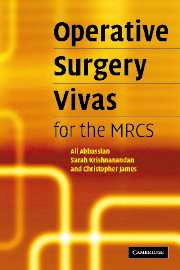Book contents
- Frontmatter
- Contents
- Preface
- 1 The elective repair of an abdominal aortic aneurysm
- 2 Adrenalectomy
- 3 Amputation (below knee)
- 4 Anorectal abscesses, fistulae and pilonidal sinus
- 5 Appendicectomy
- 6 Principles of bowel anastomosis
- 7 Breast surgery
- 8 Carotid endarterectomy
- 9 Carpal tunnel decompression
- 10 Central venous cannulation
- 11 Cholecystectomy (laparoscopic)
- 12 Circumcision
- 13 Colles' fracture (closed reduction of)
- 14 Compound fractures
- 15 Dupuytren's contracture release
- 16 Dynamic hip screw
- 17 Fasciotomy for compartment syndrome
- 18 Femoral embolectomy
- 19 Femoral hernia repair
- 20 Haemorrhoidectomy
- 21 Hip surgery
- 22 Hydrocele repair
- 23 The open repair of an inguinal hernia
- 24 Laparotomy and abdominal incisions
- 25 Oesophago-gastroduodenoscopy
- 26 Orchidectomy
- 27 Parotidectomy
- 28 Perforated peptic ulcer
- 29 Pyloric stenosis and Ramstedt's pyloromyotomy
- 30 Right hemicolectomy
- 31 Skin cover (the reconstructive ladder)
- 32 Spinal procedures
- 33 Splenectomy
- 34 Stomas
- 35 Submandibular gland excision
- 36 Tendon repairs
- 37 Thoracostomy (insertion of a chest drain)
- 38 Thoracotomy
- 39 Thyroidectomy
- 40 Tracheostomy
- 41 Urinary retention and related surgical procedures
- 42 Varicose vein surgery
- 43 Vasectomy
- 44 Zadik's procedure
43 - Vasectomy
Published online by Cambridge University Press: 16 October 2009
- Frontmatter
- Contents
- Preface
- 1 The elective repair of an abdominal aortic aneurysm
- 2 Adrenalectomy
- 3 Amputation (below knee)
- 4 Anorectal abscesses, fistulae and pilonidal sinus
- 5 Appendicectomy
- 6 Principles of bowel anastomosis
- 7 Breast surgery
- 8 Carotid endarterectomy
- 9 Carpal tunnel decompression
- 10 Central venous cannulation
- 11 Cholecystectomy (laparoscopic)
- 12 Circumcision
- 13 Colles' fracture (closed reduction of)
- 14 Compound fractures
- 15 Dupuytren's contracture release
- 16 Dynamic hip screw
- 17 Fasciotomy for compartment syndrome
- 18 Femoral embolectomy
- 19 Femoral hernia repair
- 20 Haemorrhoidectomy
- 21 Hip surgery
- 22 Hydrocele repair
- 23 The open repair of an inguinal hernia
- 24 Laparotomy and abdominal incisions
- 25 Oesophago-gastroduodenoscopy
- 26 Orchidectomy
- 27 Parotidectomy
- 28 Perforated peptic ulcer
- 29 Pyloric stenosis and Ramstedt's pyloromyotomy
- 30 Right hemicolectomy
- 31 Skin cover (the reconstructive ladder)
- 32 Spinal procedures
- 33 Splenectomy
- 34 Stomas
- 35 Submandibular gland excision
- 36 Tendon repairs
- 37 Thoracostomy (insertion of a chest drain)
- 38 Thoracotomy
- 39 Thyroidectomy
- 40 Tracheostomy
- 41 Urinary retention and related surgical procedures
- 42 Varicose vein surgery
- 43 Vasectomy
- 44 Zadik's procedure
Summary
What points should be discussed with a patient requesting a vasectomy?
This procedure should be offered to men who have completed their family. The following points should be discussed with all patients but in particular with younger men or those with very young children.
Procedure is essentially irreversible.
There is a small risk in the region of 1:2500 of not achieving sterility.
Other forms of contraception should be used post-operatively until two consecutive semen analysis specimens are negative. (At 2 and 3 months post op)
How do you perform a vasectomy?
Position The patient is placed supine on the operating table. The scrotal skin is shaved and then prepared and draped in the routine manner. A choice of general or local anaesthetic can be used.
Procedure The spermatic cord is palpated and identified through the scrotal skin. A transverse incision is made in the overlying skin and fascia (see Question 5, Chapter 22, Hydrocele repair). The vas is identified and ligated between clamps. Care is taken not to ligate the testicular artery. The vas is then divided and ligated in two points and a small central section is excised and sent for confirmatory histopathology. The fascia is then closed over one end leaving the other end overlying the fascia.
Closure Fascia is closed as above with absorbable sutures. Skin is then closed.
The procedure is repeated on the contralateral side.
What are the complications specific to vasectomy?
Infertility (if the patient changes his mind and desires to have children)
Infection
Scrotal pain
[…]
- Type
- Chapter
- Information
- Operative Surgery Vivas for the MRCS , pp. 161 - 162Publisher: Cambridge University PressPrint publication year: 2006



